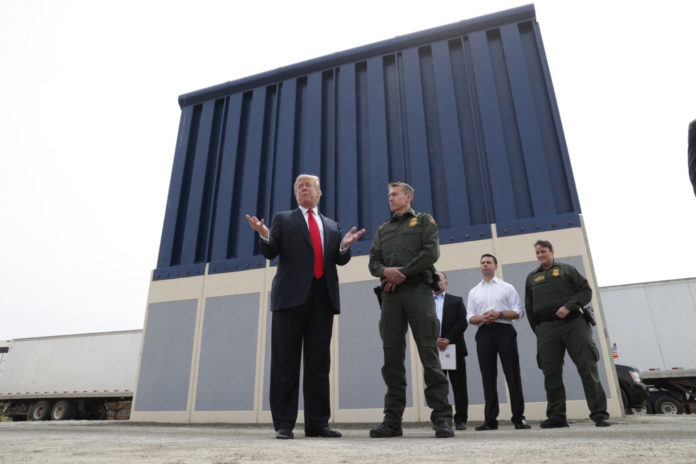
Senior Trump administration officials are considering a plan to again divert billions of dollars in military funding to pay for border barrier construction next year, a way to circumvent congressional opposition to putting more taxpayer money toward the president’s signature project, according to three administration officials.
The president has pledged to complete nearly 500 miles of new barrier by the 2020 election – stirring chants of “Build the Wall!” at his campaign rallies. But that construction goal will require a total of $18.4 billion in funding through 2020, far more than the administration has publicly disclosed, the administration’s latest internal projections show.
Planning documents obtained by The Washington Post show the cost of building 509 miles of barriers averages out to more than $36 million per mile. The documents also show that the government would need to obtain – either by eminent-domain claims or purchases – land that lies under nearly 200 miles of proposed barrier.
At a Sept. 11 meeting at the White House led by adviser Jared Kushner, senior officials discussed a plan that would press lawmakers to backfill – or reimburse – $3.6 billion of Pentagon funds that the administration diverted this year to pay for fence construction, the officials said.
The White House also has requested $5 billion for barrier funding in 2020 through the Department of Homeland Security budget, but if that money is not approved, the administration plans to dip into the Pentagon’s construction budget for the second consecutive year to get another $3.6 billion, said the officials familiar with the plan.
The Democratic majority in the House is adamantly opposed to providing additional funding for the project.
If the administration carries out the plan, the White House will have defied Congress to divert a total of $7.2 billion of Defense Department funds over two years, money that would otherwise pay to repair or upgrade U.S. military installations.
When the White House was asked about the plan Thursday, a senior official responded that the discussion was “a typical project-management meeting where administration officials discussed border wall progress” and that the goal was to ensure that border security priorities were being fulfilled “and that additional needs were being assessed in the event more funding became available.”
Trump’s urgency about barrier construction has unnerved top aides responsible for the project’s completion, and it also has raised new concerns about potential shortcuts in contracting and procurement procedures.
Two days after the White House meeting, the head of the House Oversight and Reform Committee sent a letter to Lt. Gen. Todd Semonite, the head of the U.S. Army Corps of Engineers, asking for a briefing on border barrier procurement, saying the committee was investigating whether regular contracting processes were being bypassed to build the structure more quickly.
Committee Chariman Elijah Cummings, D-Md., said lawmakers also were troubled by revelations in The Post that President Donald Trump had urged the Corps of Engineers to steer contracts to North Dakota-based Fisher Industries, a company whose top executive is a GOP donor and frequent guest on Fox News.
Cummings’s letter cited concerns that the Corps of Engineers “is being pressured to bypass regular contracting processes in order to complete construction more quickly.”
The committee gave a Friday deadline for Semonite to provide the briefing, according to the letter.
The Corps of Engineers also has been directed to hand over information about border construction bids to Sen. Kevin Cramer, R-N.D., who has promoted Fisher Industries to Trump. Cramer has said he has been “deputized” by the president to ensure that barrier construction remains on track.
A spokeswoman for the Corps of Engineers said the agency awards contracts through competitive procedures that provide “the best value to the government for the particular procurement action being undertaken.”
“As a standard practice, when publicly releasing contractual information, USACE advises our contractors and coordinates with our legal team to ensure that information released does not violate proprietary concerns,” said the spokeswoman, Raini Brunson.
Cramer, who has repeatedly pushed for Fisher Industries to get a border contract, said he was pleased to hear he would be getting the documents he had requested.
“I don’t know if Fisher or anyone else would build a better or less-expensive wall,” Cramer said Thursday. “When I was in El Paso, I saw a Fisher-built segment and another segment, and the quality from the surface and the technology implemented by Fisher was far superior. I believe it was less expensive as well.”
Cramer said he had repeatedly pushed for the documents and had been stymied. He said he did not plan to give the documents to Fisher – something military officials fear will happen. Cramer said he is working only to help the president, who he said has asked him to dive into the wall construction.
“This is my inquiry as a member of the Senate who sits on the committees with jurisdiction over the USACE,” Cramer said. “I have no plans to share the documents with anyone, depending on what they show, and I don’t imagine Fisher would be all that interested. What I’ve requested are projects that have already been awarded. If there are irregularities like high bidders getting awards over lower bidders or inadequate explanations why a company was overlooked or rejected, I’m more likely to share that information with you or other media as well as [the office of the inspector general] or the secretary of the Army or defense.”
The administration’s financial maneuvers have drawn significant criticism from lawmakers who accuse the White House of undermining military readiness to fund a project closely tied to the president’s reelection campaign.
White House budget officials told lawmakers in early 2018 that their plan was to install more than 700 miles of barriers over a decade at a cost $18 billion. The construction plan laid out by Trump appears to move the project much faster, delivering about 200 miles less for the same amount of money.
This year’s Pentagon reprogramming has taken funding away from 51 projects, generating significant opposition, so the plan discussed at the White House would first try to get lawmakers to put that money back into budgets that fund military construction and repairs.
“The plan is to sell it as replenishment money to the Defense Department for the $3.6 billion they took this year,” said one of the administration officials, who spoke on the condition of anonymity because of fears of reprisal. “Then once they got it from Congress, they would take it again.”
The House this week voted down a Republican motion to “backfill” the military construction funds. The money has been diverted from child-care facilities and schools on military bases, as well as from maintenance and repairs on U.S. bases.
Trump has pushed aides to build the border fencing as quickly as possible, brushing off concerns about property ownership and contracting procedures while reassuring others worried about wrongdoing that he will issue pardons if they are targeted for prosecution.
The administration has not said publicly how it plans to obtain funding next year to meet its ambitious construction targets, which will require the government to dramatically accelerate the pace of work and make aggressive use of federal authority to seize private land.
The planning document distributed at the meeting led by Kushner last week indicates that 187 of the 509 miles of proposed border barrier are on private land – more than one-third of the total. On Wednesday, the Department of the Interior announced the transfer of 560 acres of federal land to the Army to facilitate barrier construction along a 70-mile stretch of the border.
Trump also has taken an increasingly keen interest in aesthetic elements of the barrier, insisting it should be painted black and topped with spikes, despite the cost increases associated with those elements.
The border wall meeting led by Kushner was attended by Semonite, as well as U.S. Customs and Border Protection acting commissioner Mark Morgan, top White House budget official Russell Vought and others from the Pentagon and the White House.
The White House’s plan to ask lawmakers for additional Pentagon funds to make up for the reprogrammed money, only to divert money all over again, could outrage Democratic lawmakers who are bracing for another potential standoff with the White House this fall.
Trump forced a partial shutdown of the federal government that stretched from December into January in an attempt to gain leverage over congressional Democrats in his push for $5 billion in construction money, but the president buckled after polls showed most Americans blamed him for the impasse.
The White House then maneuvered to get the money elsewhere, largely by squeezing military construction projects. Of the $3.6 billion redirected to the border project in 2019, about half comes from projects at bases and locations overseas, while the other half has been shaved off domestic projects.
So far, the administration has installed about 65 miles of new barrier, all of it in areas where the government has replaced smaller or dilapidated fencing with imposing steel fencing as tall as 30 feet.
Touring new sections of double-layered fencing with top Homeland Security officials this week, the president likened the structure to a luxury automobile.
“I said, ‘Fellas, how about doing a less-expensive version?’ ” he told reporters. “They said, ‘Well, this is the version that works,’ including the poured concrete in the steel with the rebar and everything else.”
“That’s the Rolls-Royce version.”
(c) 2019, The Washington Post · Nick Miroff, Josh Dawsey
{Matzav.com}











